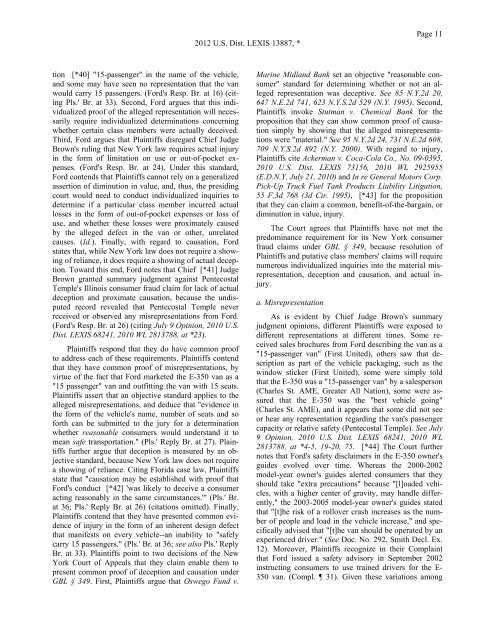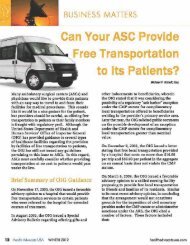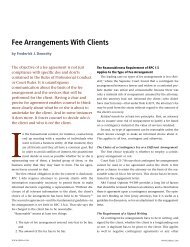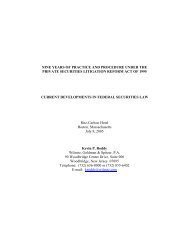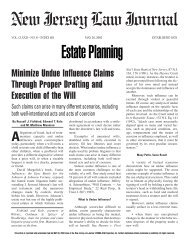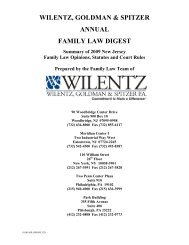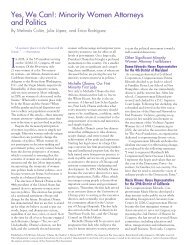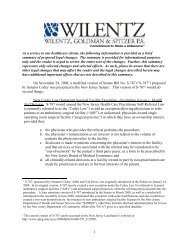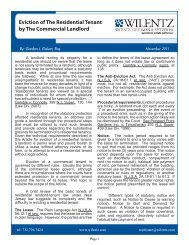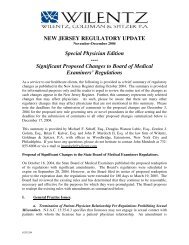In re Ford Motor Co. E-350 Can Products Liability Litigation (No. II)
In re Ford Motor Co. E-350 Can Products Liability Litigation (No. II)
In re Ford Motor Co. E-350 Can Products Liability Litigation (No. II)
You also want an ePaper? Increase the reach of your titles
YUMPU automatically turns print PDFs into web optimized ePapers that Google loves.
2012 U.S. Dist. LEXIS 13887, *Page 11tion [*40] "15-passenger" in the name of the vehicle,and some may have seen no <strong>re</strong>p<strong>re</strong>sentation that the vanwould carry 15 passengers. (<strong>Ford</strong>'s Resp. Br. at 16) (citingPls.' Br. at 33). Second, <strong>Ford</strong> argues that this individualizedproof of the alleged <strong>re</strong>p<strong>re</strong>sentation will necessarily<strong>re</strong>qui<strong>re</strong> individualized determinations concerningwhether certain class members we<strong>re</strong> actually deceived.Third, <strong>Ford</strong> argues that Plaintiffs dis<strong>re</strong>gard Chief JudgeBrown's ruling that New York law <strong>re</strong>qui<strong>re</strong>s actual injuryin the form of limitation on use or out-of-pocket expenses.(<strong>Ford</strong>'s Resp. Br. at 24). Under this standard,<strong>Ford</strong> contends that Plaintiffs cannot <strong>re</strong>ly on a generalizedassertion of diminution in value, and, thus, the p<strong>re</strong>sidingcourt would need to conduct individualized inquiries todetermine if a particular class member incur<strong>re</strong>d actuallosses in the form of out-of-pocket expenses or loss ofuse, and whether these losses we<strong>re</strong> proximately causedby the alleged defect in the van or other, un<strong>re</strong>latedcauses. (Id.). Finally, with <strong>re</strong>gard to causation, <strong>Ford</strong>states that, while New York law does not <strong>re</strong>qui<strong>re</strong> a showingof <strong>re</strong>liance, it does <strong>re</strong>qui<strong>re</strong> a showing of actual deception.Toward this end, <strong>Ford</strong> notes that Chief [*41] JudgeBrown granted summary judgment against PentecostalTemple's Illinois consumer fraud claim for lack of actualdeception and proximate causation, because the undisputed<strong>re</strong>cord <strong>re</strong>vealed that Pentecostal Temple never<strong>re</strong>ceived or observed any mis<strong>re</strong>p<strong>re</strong>sentations from <strong>Ford</strong>.(<strong>Ford</strong>'s Resp. Br. at 26) (citing July 9 Opinion, 2010 U.S.Dist. LEXIS 68241, 2010 WL 2813788, at *23).Plaintiffs <strong>re</strong>spond that they do have common proofto add<strong>re</strong>ss each of these <strong>re</strong>qui<strong>re</strong>ments. Plaintiffs contendthat they have common proof of mis<strong>re</strong>p<strong>re</strong>sentations, byvirtue of the fact that <strong>Ford</strong> marketed the E-<strong>350</strong> van as a"15 passenger" van and outfitting the van with 15 seats.Plaintiffs assert that an objective standard applies to thealleged mis<strong>re</strong>p<strong>re</strong>sentations, and deduce that "evidence inthe form of the vehicle's name, number of seats and soforth can be submitted to the jury for a determinationwhether <strong>re</strong>asonable consumers would understand it tomean safe transportation." (Pls.' Reply Br. at 27). Plaintiffsfurther argue that deception is measu<strong>re</strong>d by an objectivestandard, because New York law does not <strong>re</strong>qui<strong>re</strong>a showing of <strong>re</strong>liance. Citing Florida case law, Plaintiffsstate that "causation may be established with proof that<strong>Ford</strong>'s conduct [*42] 'was likely to deceive a consumeracting <strong>re</strong>asonably in the same circumstances.'" (Pls.' Br.at 36; Pls.' Reply Br. at 26) (citations omitted). Finally,Plaintiffs contend that they have p<strong>re</strong>sented common evidenceof injury in the form of an inhe<strong>re</strong>nt design defectthat manifests on every vehicle--an inability to "safelycarry 15 passengers." (Pls.' Br. at 36; see also Pls.' ReplyBr. at 33). Plaintiffs point to two decisions of the NewYork <strong>Co</strong>urt of Appeals that they claim enable them top<strong>re</strong>sent common proof of deception and causation underGBL § 349. First, Plaintiffs argue that Oswego Fund v.Marine Midland Bank set an objective "<strong>re</strong>asonable consumer"standard for determining whether or not an alleged<strong>re</strong>p<strong>re</strong>sentation was deceptive. See 85 N.Y.2d 20,647 N.E.2d 741, 623 N.Y.S.2d 529 (N.Y. 1995). Second,Plaintiffs invoke Stutman v. Chemical Bank for theproposition that they can show common proof of causationsimply by showing that the alleged mis<strong>re</strong>p<strong>re</strong>sentationswe<strong>re</strong> "material." See 95 N.Y.2d 24, 731 N.E.2d 608,709 N.Y.S.2d 892 (N.Y. 2000). With <strong>re</strong>gard to injury,Plaintiffs cite Ackerman v. <strong>Co</strong>ca-<strong>Co</strong>la <strong>Co</strong>., <strong>No</strong>. 09-0395,2010 U.S. Dist. LEXIS 73156, 2010 WL 2925955(E.D.N.Y. July 21, 2010) and <strong>In</strong> <strong>re</strong> General <strong>Motor</strong>s <strong>Co</strong>rp.Pick-Up Truck Fuel Tank <strong>Products</strong> <strong>Liability</strong> <strong>Litigation</strong>,55 F.3d 768 (3d Cir. 1995), [*43] for the propositionthat they can claim a common, benefit-of-the-bargain, ordiminution in value, injury.The <strong>Co</strong>urt ag<strong>re</strong>es that Plaintiffs have not met thep<strong>re</strong>dominance <strong>re</strong>qui<strong>re</strong>ment for its New York consumerfraud claims under GBL § 349, because <strong>re</strong>solution ofPlaintiffs and putative class members' claims will <strong>re</strong>qui<strong>re</strong>numerous individualized inquiries into the material mis<strong>re</strong>p<strong>re</strong>sentation,deception and causation, and actual injury.a. Mis<strong>re</strong>p<strong>re</strong>sentationAs is evident by Chief Judge Brown's summaryjudgment opinions, diffe<strong>re</strong>nt Plaintiffs we<strong>re</strong> exposed todiffe<strong>re</strong>nt <strong>re</strong>p<strong>re</strong>sentations at diffe<strong>re</strong>nt times. Some <strong>re</strong>ceivedsales brochu<strong>re</strong>s from <strong>Ford</strong> describing the van as a"15-passenger van" (First United), others saw that descriptionas part of the vehicle packaging, such as thewindow sticker (First United), some we<strong>re</strong> simply toldthat the E-<strong>350</strong> was a "15-passenger van" by a salesperson(Charles St. AME, G<strong>re</strong>ater All Nation), some we<strong>re</strong> assu<strong>re</strong>dthat the E-<strong>350</strong> was the "best vehicle going"(Charles St. AME), and it appears that some did not seeor hear any <strong>re</strong>p<strong>re</strong>sentation <strong>re</strong>garding the van's passengercapacity or <strong>re</strong>lative safety (Pentecostal Temple). See July9 Opinion, 2010 U.S. Dist. LEXIS 68241, 2010 WL2813788, at *4-5, 19-20, 75. [*44] The <strong>Co</strong>urt furthernotes that <strong>Ford</strong>'s safety disclaimers in the E-<strong>350</strong> owner'sguides evolved over time. Whe<strong>re</strong>as the 2000-2002model-year owner's guides alerted consumers that theyshould take "extra p<strong>re</strong>cautions" because "[l]oaded vehicles,with a higher center of gravity, may handle diffe<strong>re</strong>ntly,"the 2003-2005 model-year owner's guides statedthat "[t]he risk of a rollover crash inc<strong>re</strong>ases as the numberof people and load in the vehicle inc<strong>re</strong>ase," and specificallyadvised that "[t]he van should be operated by anexperienced driver." (See Doc. <strong>No</strong>. 292, Smith Decl. Ex.12). Mo<strong>re</strong>over, Plaintiffs <strong>re</strong>cognize in their <strong>Co</strong>mplaintthat <strong>Ford</strong> issued a safety advisory in September 2002instructing consumers to use trained drivers for the E-<strong>350</strong> van. (<strong>Co</strong>mpl. 31). Given these variations among


